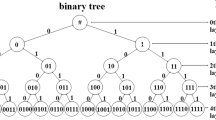Abstract
Tag collision prevention/resolution for radio frequency identification (RFID) tags is one of the most significant issues for fast tag identification. This paper proposes a new anti-collision protocol that has objective of minimizing the tag identification delay. The proposed scheme reduces the tag collisions by allocating exclusive timeslot to each tag using identified timeslot information. Performance evaluation based on numerical and simulation results shows that the proposed anti-collision method improves RFID identification performance.




Similar content being viewed by others
Abbreviations
- DFSA:
-
Dynamic framed slotted Aloha
- RFID:
-
Radio frequency identification
References
Klair, D. K., Chin, K.-W., & Raad, R. (2010). A survey and tutorial of RFID anti-collision protocols. IEEE Communications Surveys and Tutorials, 12(3), 400–421.
Yim, S.-B., Park, J., & Lee, T.-J. (2012). Novel dynamic framed-slotted Aloha using litmus slots in RFID systems. IEICE Transactions on Communications, E95–B(4), 1375–1383.
Hush, D. R., & Wood, C. (1998). Analysis of tree algorithms for RFID arbitration. In The IEEE Intl. Symposium on Information Theory (pp. 107–107).
Myung, J., Lee, W., & Srivastava, J. (2006). Adaptive binary splitting for efficient RFID tag anti-collision. IEEE Communications Letters, 10(3), 144–146.
Finkenzeller, K. (2003). RFID handbook, fundamentals and applications in contactless smart cards and identification. New York: Wiley.
Burdet, L. A. RFID multiple access methods. Technical Report, http://www.vs.inf.ethz.ch/edu/SS2004/DS/reports/06_rfid-mac_report.pdf.
Park, J., Chung, M. Y., & Lee, T.-J. (2007). Identification of RFID tags in framed-slotted Aloha with robust estimation and binary selection. IEEE Communications Letters, 11(5), 452–454.
Klair, D. K., Chin, K.-W., & Raad, R. (2007). On the suitability of framed Aloha based RFID anti-collision protocols for RFID-Enhanced WSNs. In The 16th IEEE international conference on computer communications and, networks (pp. 583–590).
Schoute, F. C. (1983). Dynamic frame length ALOHA. IEEE Transactions on Communications, 31(4), 565–568.
Cha J.-R., & Kim, J.-H. (2005). Novel anti-collision algorithms for fast object identification in RFID system. In: The 11th intl. conference on parallel and distributed systems (pp. 63–67).
Author information
Authors and Affiliations
Corresponding author
Rights and permissions
About this article
Cite this article
Joo, YI., Seo, DH. & Kim, JW. An Efficient Anti-collision Protocol for Fast Identification of RFID Tags. Wireless Pers Commun 77, 767–775 (2014). https://doi.org/10.1007/s11277-013-1535-8
Published:
Issue Date:
DOI: https://doi.org/10.1007/s11277-013-1535-8




